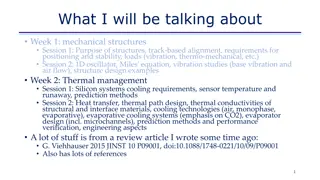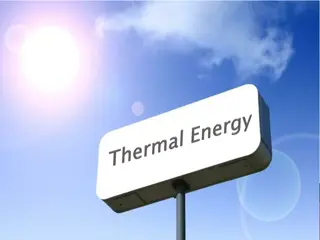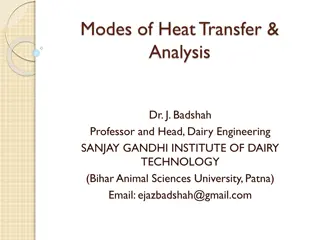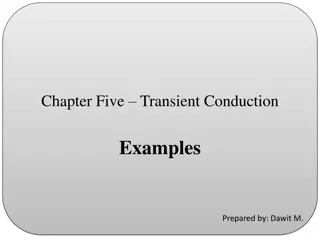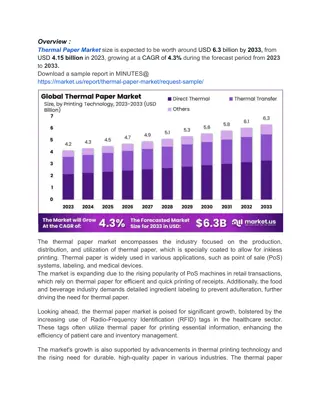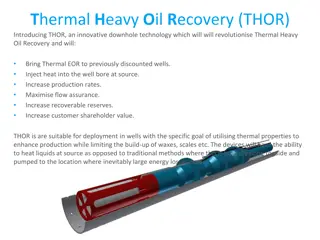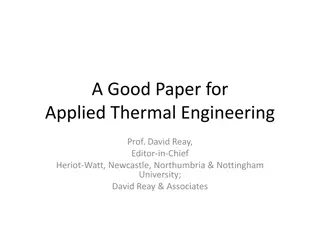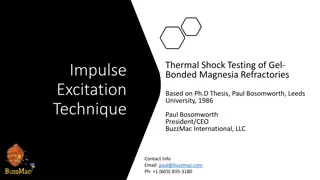Thermal Working Group Update and Programs Overview
The Thermal Working Group (TWG) acts as a coordinating body to facilitate the development, integration, and dissemination of thermal data for civil users. This group is focused on enhancing the capabilities of systems like Hawkeye, which provides near real-time wildland fire alerts to various agencies. The TWG also oversees the Firefly program, which assists National Guard analysts in extracting key features related to wildfire activities. Both Hawkeye and Firefly aim to improve early fire detection and monitoring for better response strategies.
Download Presentation

Please find below an Image/Link to download the presentation.
The content on the website is provided AS IS for your information and personal use only. It may not be sold, licensed, or shared on other websites without obtaining consent from the author.If you encounter any issues during the download, it is possible that the publisher has removed the file from their server.
You are allowed to download the files provided on this website for personal or commercial use, subject to the condition that they are used lawfully. All files are the property of their respective owners.
The content on the website is provided AS IS for your information and personal use only. It may not be sold, licensed, or shared on other websites without obtaining consent from the author.
E N D
Presentation Transcript
UNCLASSIFIED UNCLASSIFIED Thermal Working Group Update 23 Oct 2018 UNCLASSIFIED UNCLASSIFIED
UNCLASSIFIED Thermal Working Group Charter The Thermal Working Group (TWG) is a coordinating body for advancing and enabling the development, delivery, and sustainment of data, information, or products derived from classified thermal remote sensing platforms to civil users. This includes facilitating the integration of thermal detection systems and the collection, processing, exploitation and dissemination of thermal events. The TWG is co-chaired by: Civil Applications Committee (CAC) National Geospatial-Intelligence Agency (NGA) UNCLASSIFIED
UNCLASSIFIED FY 2018/2019 Focus FY 2018 Improving Hawkeye performance Establishing the Firefly program FY 2019 Increasing number of Aircraft 3 Infrared Interpreters (IRINs) Implementing the Firefly Program UNCLASSIFIED
UNCLASSIFIED Hawkeye Hawkeye is: An automated system that compiles information from multiple sources and assesses the consolidated input for indications of a wildland fire It provides near real-time wildland fire alerts to federal, state, and local wildland fire agencies via the US Forest Service (USFS) It is available nationwide 24/7/365 at a 1 km accuracy Hawkeye provides: Initial detection alerts with 30 minute updates Date/Time, Latitude, Longitude, Confidence Factor Alerts available via Enterprise Geospatial Portal (EGP) UNCLASSIFIED
UNCLASSIFIED Hawkeye Improvements Pros Reduce number of false positives to as close to zero as possible Improve closely spaced object separation Cons Increased processing time by 30 to 150 seconds UNCLASSIFIED
UNCLASSIFIED Firefly Firefly is: A system that compiles information similar to Hawkeye and provides the output to National Guard analysts for feature extraction Extracted features are integrated with additional information and reported by the National Guard through the Firewatch program Support must be requested focus on anticipated Fire Sieges and Lightning Busts or significant ongoing wildfire activity Firefly can be used for: Early indications of new fire starts Near real-time updates of fast moving fires or unexpected changes in fire behavior Daily or on demand coarse fire perimeter summaries UNCLASSIFIED
UNCLASSIFIED Firewatch Vision An integrated system that supports all sensors into a single common operating picture: meet the ten standard fire orders to both to know what the fire is doing at all times make the most informed decisions based on values at risk and timely integrated partner response on current and expected fire behavior Real-time synthesis of all sensors: satellites automated and piloted aircraft radar remote cameras, RAWS, down to cell phone photos Envisioned technological changes: are integrated with existing systems (EGP) may provide opportunities for improvements in other areas of wildfire management UNCLASSIFIED
UNCLASSIFIED Firefly Status California Guard on-board: Trained on Firefly analysis Receiving live data Creating candidate products for evaluation Awaiting policy approval to disseminate Begin dissemination as soon as CONOPS is approved Initial Recipients US Forest Service Intel Operations at local Geographic Area Operations Centers After action meeting planned for Spring 2019 UNCLASSIFIED
UNCLASSIFIED Initial Reporting Examples Butte Fire 9 Sep 2015 Pioneer Fire 18 Jul 2016 Junkins Fire 17 Oct 2016 Time (Zulu) Time (Local) Delta (mins) Time (Zulu) Time (Local) Delta (mins) Time (Zulu) Time (Local) Delta (mins) Estimated Start 00:00 17:00 Estimated Start 09:45 03:45 Estimated Start 22:26 14:26 First Input First Input Low Alert Medium Alert High Alert 23:58 23:58 00:37 00:38 00:41 16:58 16:58 17:37 17:38 17:41 - -2 2 +37 +38 +41 First Input First Input Low Alert Medium Alert High Alert 09:17 09:17 - 09:19 09:24 03:17 03:17 - 03:19 03:24 - -28 28 - -26 -21 First Input First Input Low Alert Medium Alert High Alert 22:54 22:54 23:03 23:06 23:10 14:54 14:54 15:03 15:06 15:10 +28 +28 +37 +40 +44 NOTE: Can be up to 5 minutes between time stamp in the alert and receipt at EGP Initial detection performance appears to favor dry, windy conditions where wildfires can become large, very fast UNCLASSIFIED
UNCLASSIFIED Initial Reporting Examples Tubbs Fire 8 Oct 2017 Thomas Fire 4 Dec 2017 Time (Zulu) Time (Local) Delta (mins) Time (Zulu) Time (Local) Delta (mins) Estimated Start 02:28 18:28 Estimated Start 04:45 21:45 First Input Low Alert Medium Alert High Alert 02:21 - - 02:41 18:21 - - 18:41 -7 - - +13 First Input Low Alert Medium Alert High Alert 04:46 - 04:54 05:24 21:46 - 21:54 22:24 +1 - +9 +39 NOTE: Can be up to 5 minutes between time stamp in the alert and receipt at EGP UNCLASSIFIED








